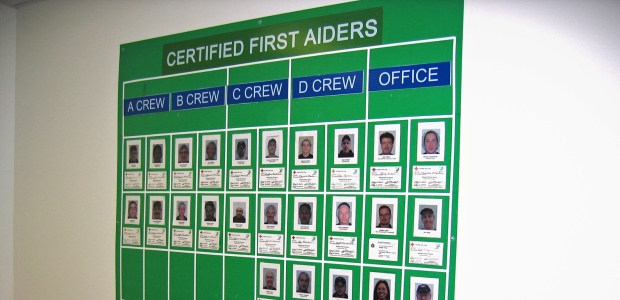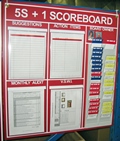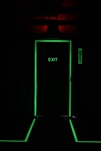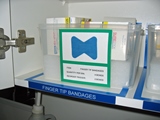
Key Visual Management Strategies
These 10 uses of visual management can improve the safety of your facility.
- By Rhonda Kovera
- Feb 01, 2014
Many companies spend millions of dollars developing safe work methods, training staff in safe procedures, and purchasing safety equipment. But regardless of the amount of time and money that is devoted to safety, it's all too common for employees on the plant floor to disregard correct procedures and forget about or misuse safety equipment. Many companies are addressing these challenges by providing visual management systems at the point of action in the plant that continually engage, teach, and remind employees of what is required to maintain a safe working environment.
Visual management tools give employees information that compels them to take positive steps to impact the business and process. They supplement work instructions by reinforcing the right way to do things at the point of action. They help to ensure that people are doing the right thing, the right way, at the right time and for the right reason, even when no one is watching. This is why strategically placing visual management controls and displays at the point of use to emphasize critical actions can help to improve the safety of your facility. This article will provide some specific recommendations how to use visual management techniques to improve safety.
1. Posting and Reviewing Safety Audit Results in Team Meetings
One of the most powerful methods for improving workplace safety is to post safety metrics in the work area. Consider posting relevant metrics at the location where team members have their daily huddle. Tables, charts, symbols, text, or all of the above can be used to display key information, such as the number of recordable injuries for the department and the plant. Making this information instantly visible will make it clear to every team member whether or not there is a problem and, if there is a problem, will encourage them to take action to address it. To make sure that the information is updated on a regular basis, post a picture of the owner of the information who is responsible for keeping it current.
 Use creativity when developing visual systems. One plant uses a manikin called Safety Sam to display safety information. Safety Sam carries a signboard that shows year-to-date safety performance for the plant and department at a glance. He is located at a point nearly every employee walks by, so the message reaches everyone. The display shows how many injuries have been recorded using the safety cross.
Use creativity when developing visual systems. One plant uses a manikin called Safety Sam to display safety information. Safety Sam carries a signboard that shows year-to-date safety performance for the plant and department at a glance. He is located at a point nearly every employee walks by, so the message reaches everyone. The display shows how many injuries have been recorded using the safety cross.
When the facility has a recordable injury, Safety Sam's hat is changed from green to red for the day.
2. Organizing the Workplace to Reduce Injuries
The presence of unnecessary objects in the workplace can be detrimental to productivity and also creates safety hazards. The first step to reduce clutter is to evaluate everything in the workplace to determine whether it is truly a part of the process. The workplace should be organized so that a specific location is defined for all essential tools, and unnecessary items should be removed. Either an outline or a label, or both, can be used to indicate clearly where needed objects should reside when they are not being used.
 The image shown here is of a visual system used to track and monitor responsibility for workplace cleanliness. Tasks are divided into daily, weekly, and monthly frequency. A card is created for each task and then filed in a card holder. The color of the card identifies the frequency of the task and what action is required. When the task is complete, the card is turned over. It is easy to see when tasks have not been completed or if the team is behind schedule. The owners of the scoreboard are clearly displayed so that if anyone has a question, they know whom to ask.
The image shown here is of a visual system used to track and monitor responsibility for workplace cleanliness. Tasks are divided into daily, weekly, and monthly frequency. A card is created for each task and then filed in a card holder. The color of the card identifies the frequency of the task and what action is required. When the task is complete, the card is turned over. It is easy to see when tasks have not been completed or if the team is behind schedule. The owners of the scoreboard are clearly displayed so that if anyone has a question, they know whom to ask.
3. Visually Identifying Safety Equipment
Safety equipment should be stored in plain sight and be clearly identified with signs and, if possible, color coded. The idea is that team members will take note of the location of the equipment when they pass by and easily will be able to find it in an emergency. If specific actions are required for safe operation, these actions should be displayed. For example, lockout/tagout equipment should include instructions, pinch points should be clearly identified, and safe locations to operate equipment should be displayed, such as by placing footprints on the floor. Electrical panels, charging stations, and other designated areas should be clearly identified, and the areas that must be kept clear should be marked off to avoid obstructing them.
4. Marking Emergency Evacuation Routes
 Most companies have dedicated evacuation routes and locations that employees must assemble after evacuation for a headcount. Emergency exits should be identified with battery-powered lights and routes should be marked with glow products that will be visible in the event of a power failure. Warnings should be posted to avoid obstructing emergency routes and exits.
Most companies have dedicated evacuation routes and locations that employees must assemble after evacuation for a headcount. Emergency exits should be identified with battery-powered lights and routes should be marked with glow products that will be visible in the event of a power failure. Warnings should be posted to avoid obstructing emergency routes and exits.
5. Controlling First Aid Supplies with a Kanban System
 Many companies have implemented a Kanban system for tracking production inventory. Kanban cards are located at the point of inventory with replenishment instructions, such as: When inventory has dropped to 20 pieces, order 50 pieces. This simple and effective system also can be used to ensure that first aid supplies are always available, and it avoids the time and effort required to track usage of supplies.
Many companies have implemented a Kanban system for tracking production inventory. Kanban cards are located at the point of inventory with replenishment instructions, such as: When inventory has dropped to 20 pieces, order 50 pieces. This simple and effective system also can be used to ensure that first aid supplies are always available, and it avoids the time and effort required to track usage of supplies.
6. Using Visual Controls to Keep Exits Clear
Exits, and particularly emergency exits, must be kept clear of obstructions at all times. There is a strong tendency for people moving equipment and materials in and out of and around the plant to set items down by the doors with the intention to come back for them soon. This hazard can be avoided by marking areas around exits bright yellow or red to indicate that they cannot be blocked. Paint can be used to mark the floor, but colored adhesive tape takes less time to apply and also takes less effort to remove in case changes are needed.
7. Visual Identification of First Responders
It's important that employees know the first responders on their shift so that they are in a position to notify them quickly in case of an emergency. The best approach is to post pictures of first responders along with their names for each shift in locations where they will be continually seen by employers as a reminder.
8. Using Visual Controls and Displays to Reinforce Safety Procedures
The benefits of standardized work instructions include documentation of the current process for all shifts, reductions in variability, easier training of new operators, reductions in injuries and strain and establishment of a baseline for continuous improvement. As soon as work instructions are developed for people, machine operations, process controls, tools, maintenance, training, etc. they should be positioned in the proper position for each operation in the facility. All procedures that have safety implications should be clearly summarized with visual controls and displays near the point where the procedure is performed. Standardized work instructions, once established and displayed at workstations, should be the object of continuous improvement.
9. Simplifying MSDS Relabeling
Material safety data sheets (MSDSs) contain critical information on the dangers involved in a particular material, handling instructions, and what to do in case of an emergency. In some plants, operators frequently have to replace MSDS labels because the substance in the container attacks the adhesive used to fasten the labels. Searching for the correct label can be time-consuming in plants that use many different materials. In most plants, there are only a small number of materials whose MSDS labels needs to be replaced on a regular basis. The time spent replacing MSDS labels can be dramatically reduced by creating a visual display containing these labels.
10. Providing Employees with Visual Tools to Notify Management of Safety Issues
Safety issues should be immediately brought to management’s attention so that the problems can be addressed before an injury occurs. Visual feedback systems have the advantage of being readily accessible, even for employees on late shifts or employees who might shy away from raising the issue face to face. The visual management system can be customized to incorporate other topics, such as root causes, action items, etc.
Visual management tools and techniques can contribute to a safer work environment by engaging your staff to actively participate in continuous improvement. As your employees become educated in the principles of visual management, employees devote increasing amounts of energy to identifying and resolving safety issues. The best leaders, best teams, and best organizations leverage visual management tools to create a culture of adaptability, trust, respect, and continual learning that ensures a safe workplace.
This article originally appeared in the February 2014 issue of Occupational Health & Safety.